Now a day, eating USDA Choice grade beef on a regular basis can become expensive for the average retail consumer. The home further processing practices advocated in this post reflect the eating preferences of my family.

I chose chuck rolls due to their great versatility and knuckles because they are lean, contain a fair amount of flavorful collagen and will therefore grind/blend well with fat trimmings from the chuck rolls. The combined price per pound from Sam’s Club, of starting raw beef, was still at a relatively high $3.10 per pound.
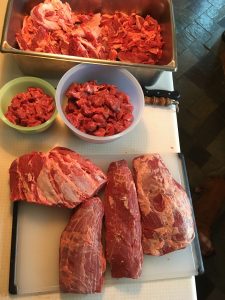
Pictured is the yield of one of the three chuck rolls from the wholesale case. We don’t like chuck roasts so the cuck-eye roll went to lean stew beef and its trimmings to grind. Tapered edges to the Denver steak muscle (Serratus ventralis) went to beef for stir-fry. I have never been pleased with the eating tenderness of Denver steaks, but have found that the squared up muscle makes delicious – well marbled corned beef. Squared-up beef Serrratus ventralis is also a good (and often less expensive) smoked brisket alternative, but is more tender so less moist-heat cooking time is required; additionally shorter cooks aid in finished product moisture retention. The Splenius muscle resembles a flank steak and makes a nice lean London broil style cut. When lopped in half lengthwise, lean Rhomboideus muscles are great for producing knife-cut beef jerky.
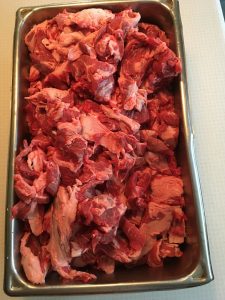
About 35 pounds of delicious chuck roll trimmings, for enhancing a sirloin tip containing grind.
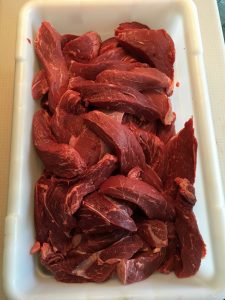
Inspect cap-off sirloin tips well in the patella (kneecap) area to remove all heavy connective tissue and possible femur bone skin. This is a pic of the entire wholesale case of knuckles/sirloin tips stripped up into grindable size pieces.
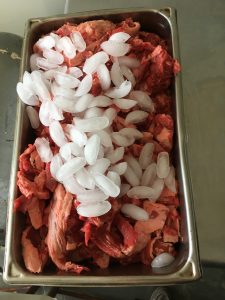
A little ice was used to facilitate grinding and add moisture (water weight) to chuck trim on its first time trip through the 3/16 inch plate.
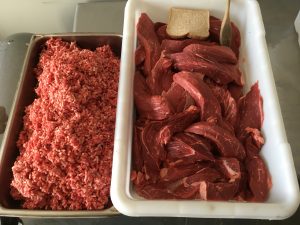
For the final grind, fatter and lean beef were intermittently fed through the same 3/16 plate. Fat component was ground twice to further reduce particle size/aid in more uniform fat distribution throughout the final ground product. Being very cold from ice grinding helped reduce fat smearing. A slice of frozen bread was ground last to help push high-dollar meat out of the grinder head. Cost of this Choice ground beef (no old beef breeding stock meat was used) was right around $3.03 per pound. Since all grind was from whole muscle cuts e-coli risks were greatly reduced and so without the need for common organic chemical trimmings interventions.
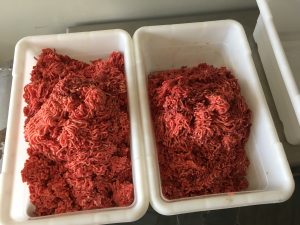
About 88 pounds of ground beef as it looked immediately after grinding. This means that approximately 39 pounds of higher-priced beef cuts were generated from the chuck rolls.
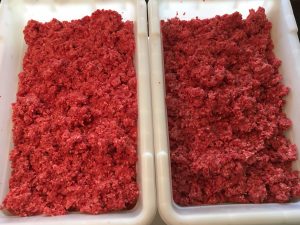
Choice ground beef was then hand mixed a bit in order to achieve better fat and lean component distribution. Individual bags of ground beef will be further blended when salt is added during meal preps. Mixing in salt gets it to where it will react with all meat to add uniform flavor and aid in finished product moisture retention via swelling muscle proteins. Salt enhances fat oxidation; so should not be added before freezer storage. If you are going to freeze sausage, the usage of purified salt is recommended because nitrate containing salt (like most sea salt) can partially cure fresh meat; yielding undesirable pinkish looking fully-cooked product.

Home freezer restocked with Choice ground beef and cuts.
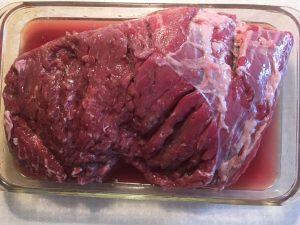
One 3 1/2 pound Denver Steak muscle was not frozen and went immediately into corned beef production. Cure, salt and sodium phosphate volume estimates were figured for the meat weight. A little brown sugar was also dissolved in as much water as I thought I would be able to pump into the roast. The pictured piece of meat is fully pumped and heading for overnight refrigeration. Roast was flipped once or twice during refrigerated curing.

Cured meat on a rack, in a coverable roasting pan, with a bottom full of water in the bottom pan (for steam generation), to cook at 170F to at least 145F internal meat temperature.
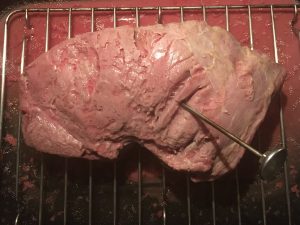
Ended up going a little high on the internal meat temperature. Practice makes perfect. Meat thermometer was left in roast until it cooled (rested) enough to stop purging.

Corned beef was split along the natural vein line to facilitate easy cross-grain slicing.

Most of this well marbled corned beef got eaten at a birthday party. The little bit left on the ends went into coned beef hash the following morning.

A beef Splenius muscle fresh from the freezer.
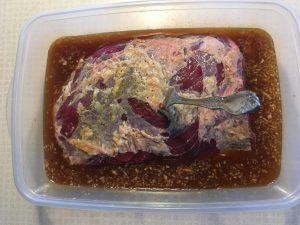
Roast was partially thawed on a microwave defrost cycle then a sodium phosphate containing marinate was forked into the semi-rigid meat. That practice helps breakdown muscle fibers and provides somewhat open channels for marinate absorption.
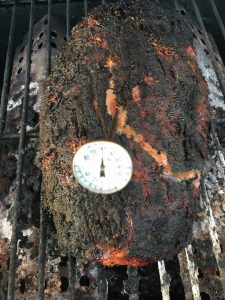
This London broil style cut then went onto a high-heat grill until it reached an internal temperature of 120F. It has been my experience that whole muscle cuts plump up quite a bit during cooking; so I went low and pulled it from the heat at 120F.

Unfortunately, pulling this London broil from the grill at 120F was not low enough to achieve a medium rare finished product. I’m guessing that a combination of high heat on the roast’s exterior and being a plumped up whole muscle sent the cold-spot temperature to almost 140F before starting to decline. Once again, practice makes perfect.
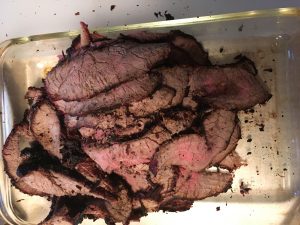
Finished thin-sliced London broil was plenty tender, but lack desired juiciness; especially in tapered end slices.
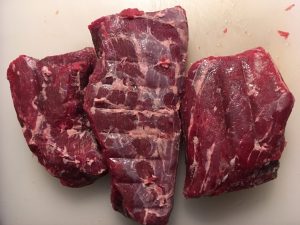
2 Rhomboieus muscles just out of the freezer. The ones on either side were lopped in half prior to freezer storage. In hind-sight, I could have denuded them of fat better and used the trim in grind.
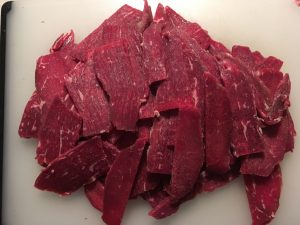
The longer piece from above was also cut in half after partial thawing then thin, with the grain, jerky slices were made.
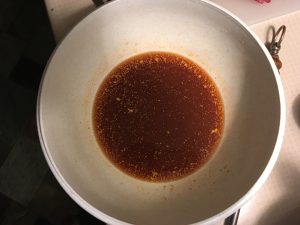
Meat weight was 4 pounds so I estimated by volume enough cure, salt, brown sugar and soy sauce to marinate it. Pink-salt, purified salt and soy sauce are all sources of salt so don’t over do it by putting in the full amount of salt called-for, by meat weight.
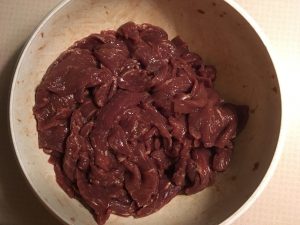
Nice lean cured jerky meat after being overhauled a few times during overnight refrigeration. As with my home processed corned beef, cure accelerator was not required for continuous processing because I wanted to allow time for flavor ingredients to more fully absorb throughout the meat.
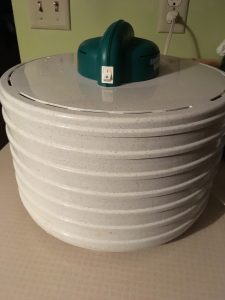
This little $40, 6 tray dehydrator did a good job on 4 starting raw pounds of meat for jerky. The trays were rotated a couple of times during the 7 hour running time in an effort to assure finished product uniformity.
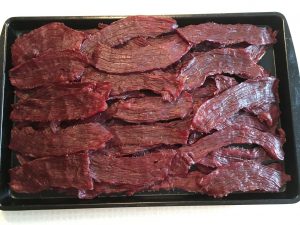
Dehydrated jerky was then pasteurized in a 170F oven for 1/2 hour as a food safety precaution. Finished product was plenty chewy, but not chewy enough to warrant the use of enzymatic meat tenderizers; as is commonly done in beef jerky processing.

Package of partially frozen stew beef being cut smaller for stew production. This chuck-eye meat cooked very tender by the time potatoes and onions became soft. I cook most of my soups etc. in the oven; in covered roasting pans. That practice allows for minimal stirring and works well because I can then get away from the stove long enough do other things.
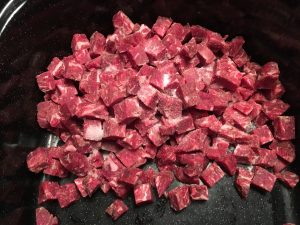
Post re-dicied stew beef in oven roasting pan.
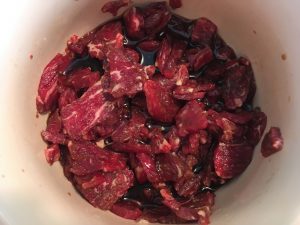
A package of partially frozen beef for stir-fry that was sliced fairly thin then put down in a salty marinate. These small pieces of beef turn out plenty tender when added lastly, and are basically just browned prior to serving.
Choice grounds beef’s versatility largely speaks for itself. However, I recently made very good meat loaf by combining pork sausage, ground beef, about 8 % fine diced onion by weight, a tablespoon or two of rolled oats, one egg and a little more salt & spices. Salt is a multifunctional mineral; which is also very useful for seasoning food. I have also suggested to my two married daughters that they can quickly microwave thaw packs of ground beef, season the meat, brown it all up and then refreeze the precooked product in smaller amounts for use as convenient baby food.

One thought on “Choice Beef “Hack””
Comments are closed.